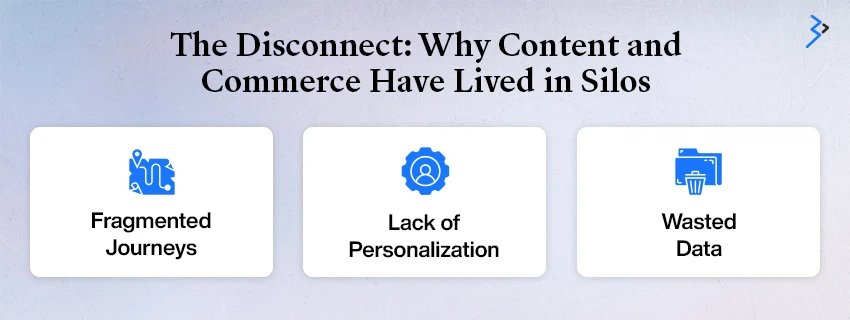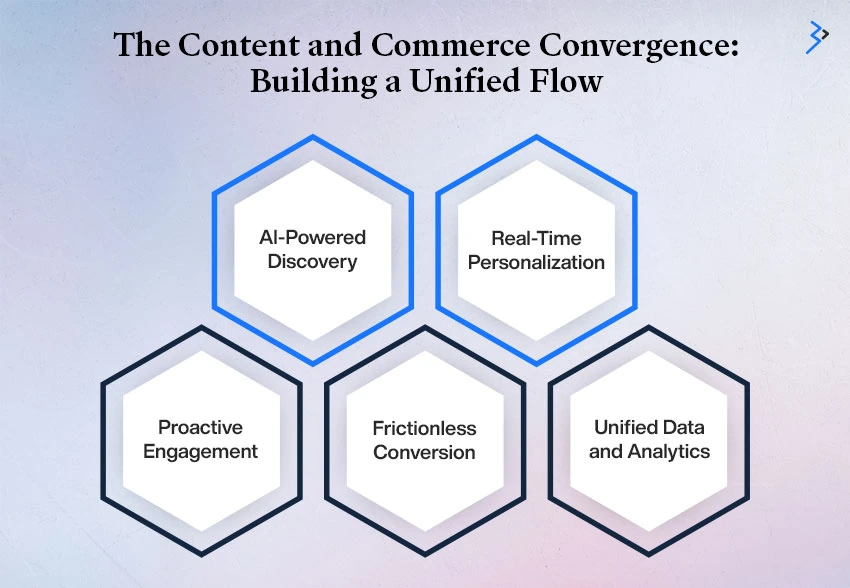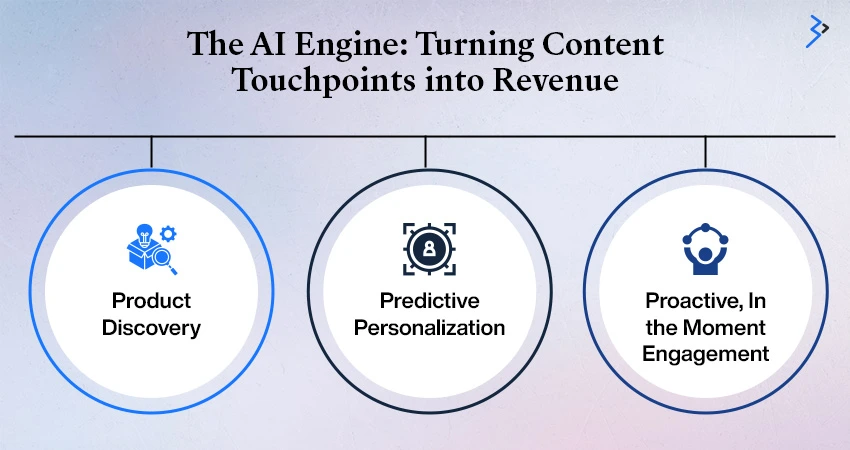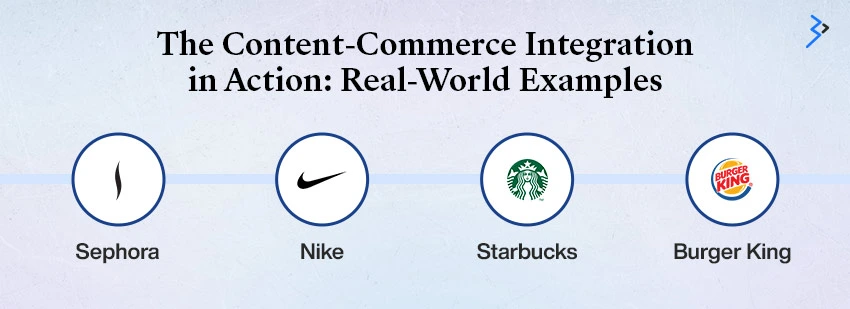Table of contents
The Disconnect: Why Content and Commerce Have Lived in Silos
The Content and Commerce Convergence: Building a Unified Flow
The AI Engine: Turning Content Touchpoints into Revenue
The Content-Commerce Integration in Action: Real-World Examples
The ROI of AI-Powered Mobile Touchpoints
Conclusion: Your Mobile Future is Now
Frequently Asked Questions
Open your phone. What’s the first thing you do? Scroll through social media? Check the news? Glance at your inbox? Each of those actions, each “mobile touchpoint”, is a potential conversation. And for too long, businesses have failed to turn these conversations into revenue.
They’ve built beautiful content experiences over here and clunky, transactional commerce experiences over there, hoping consumers will make the leap on their own.
That gap is costing you.
Mobile is no longer just a channel but the primary way customers live, breathe, and shop. Globally, mobile commerce is a $2 trillion market, making up over 57% of all eCommerce sales, according to Statista. Cropink reports that by the end of 2025, mobile sales are projected to reach $6.5 trillion globally. In the USA, the shift is just as dramatic: over 76% of adults use their smartphones to make online purchases, according to Pew Research.
The opportunity isn’t just to be mobile-friendly; it’s to be mobile-native. It’s to use every piece of content, from an Instagram story to a push notification, as a seamless bridge to a purchase. The key to unlocking this is AI-powered integration.
In this article, we will explore how brands use artificial intelligence to dissolve the barriers between content and commerce, creating a frictionless, personalized mobile experience that turns every scroll, tap, and swipe into a revenue-driving moment.
The Disconnect: Why Content and Commerce Have Lived in Silos
For years, the digital marketing ecosystem has been divided. On one side, you have the Content Team: creative strategists focused on building brand narratives, engaging with audiences, and telling stories on social media, blogs, and marketing emails. Their goal is engagement and loyalty. On the other hand, you have the Commerce Team: product managers and developers focused on conversions, seamless checkout, and optimizing the product page. Their goal is the transaction.
This division, once a simple matter of specialization, has created a fragmented customer experience, especially on mobile.
- Fragmented Journeys: A customer might discover a product on an influencer’s Instagram post, but then have to navigate to a generic mobile website, search for the item, and add it to their cart—all while battling slow load times and tiny buttons. The momentum is lost, and so is the sale.
- Lack of Personalization: A brand’s blog might be a trove of valuable information, but if it’s disconnected from the commerce engine, it can’t offer product recommendations based on what the user is reading. Content is generic; commerce is a static catalog.
- Wasted Data: Rich behavioral data from content interactions (e.g., what videos a user watched, and what articles they read) is often siloed from purchase data. Without a unified view, brands are flying blind, unable to personalize effectively.
This disconnect is why mobile app users are 3x more likely to convert than mobile website visitors according to MobiLoud. Mobile application development, by their very nature, offers a more integrated experience. But without AI, even they can’t reach their full potential.
The Content and Commerce Convergence: Building a Unified Flow
The solution is not to merge your content and commerce teams into a single department, but to connect their ecosystems with an intelligent layer. This is the Content and Commerce Convergence. It’s the strategic approach of using content to fuel discovery and desire, and then making the path to purchase so seamless that it feels like a natural extension of the content itself. AI is the engine that powers this frictionless flow.
This new model is centered around five key principles:
- AI-Powered Discovery: Using AI to surface relevant products within content, creating “shoppable” experiences.
- Real-Time Personalization: Dynamic content and product recommendations that adapt to the user’s live behavior.
- Proactive Engagement: Leveraging AI to reach customers at the right moment with the right message.
- Frictionless Conversion: Removing every possible barrier between discovery and purchase.
- Unified Data and Analytics: Connecting content consumption data with commerce transactions for a holistic customer view.
Read More - Beyond the Hype: Real-World Applications of AI in eCommerce Mobile Apps
The AI Engine: Turning Content Touchpoints into Revenue
AI is the glue that binds content and commerce, providing the intelligence needed to scale personalized, in-the-moment experiences. Here’s how it works at different stages of the mobile journey:
01 | Product Discovery
- Visual Search: This is probably the most powerful example of mobile content-commerce integration. Customers see a product they like in a photo on social media or a blog. Instead of a manual search, AI lets them snap a picture of it and instantly find the item, or similar ones, in your catalog. This bridges the gap between inspiration and transaction instantly. ASOS’s visual search tool is a prime example of this in action.
- Generative AI for Content: Generative AI can analyze a user’s purchase history and browsing behavior to generate personalized content that sparks interest. It can create unique product descriptions, blog post summaries, or even personalized style guides that feature products a user is likely to buy. This moves content from being a static resource to a dynamic, transactional tool.
02 | Predictive Personalization
This is where AI truly shines, turning passive browsing into a guided, highly relevant shopping journey.
- Hyper-Personalized Recommendations: Beyond simple “people who bought this also bought...” recommendations, AI uses predictive analytics to understand a user’s intent. Based on browsing history, past purchases, and real-time session data, it can predict what they’ll be interested in next, whether it’s a blog post, a product, or a cross-sell opportunity.
- Dynamic Content: AI can automatically change the content on a mobile app or website in real time. For example, if a user clicks on a running shoe from a push notification, the app’s homepage could instantly change to feature running-related articles, videos, and apparel. This ensures that every piece of content is perfectly aligned with the user’s immediate interests.
03 | Proactive, In-the-Moment Engagement
Mobile is about real-time, in-the-moment interactions. AI enables brands to be proactive rather than reactive.
- Intelligent Push Notifications: Iterable reports that a well-timed push notification has a 30% higher conversion rate than other marketing messages. AI takes this further by sending the proper notification at the right time. For example, a customer who abandoned a cart of shoes might receive a notification 30 minutes later offering free shipping on that specific item.
- AI-Powered Chatbots and Virtual Assistants: These aren’t just for customer service anymore. A sophisticated, AI-powered chatbot can guide a user through a product discovery journey based on their questions, offering shoppable content, personalized recommendations, and even completing the transaction right within the chat window.
Read More - The AI Marketing Playbook: Decoding Secrets from the Visionaries
The Content-Commerce Integration in Action: Real-World Examples
Integrating content and commerce with AI is a new frontier. Still, many top brands are already executing the foundational principles, paving the way for the next evolution.
- Sephora: Sephora is a master of mobile content and commerce. Their “Virtual Artist” feature, powered by Augmented Reality and AI, allows customers to try on makeup virtually. This turns content (a user’s face) into an immediate commerce opportunity. The app also offers personalized tips, tutorials, and product recommendations based on a user’s unique profile, making every interaction educational and transactional.
- Nike: Nike’s app, SNKRS, is a pure content-commerce play. It’s not just a store; it’s a community. It features exclusive content like behind-the-scenes stories, interviews with designers, and live events. The app uses AI to curate a personalized feed of content and products, creating hype and loyalty around new releases. The result? A highly engaged audience that converts at an incredible rate.
- Starbucks: The Starbucks app is a classic example of using content to drive commerce. It provides a seamless mobile ordering and payment experience, but its success is powered by personalized content. The app’s AI analyzes a user’s purchase history and behavior to send hyper-personalized offers and loyalty rewards, turning a simple content touchpoint (a push notification) into a revenue-driving moment.
- Burger King: Burger King used geofencing and AI to turn the mobile touchpoint of proximity into a massive marketing success. Their “Whopper Detour” campaign used the brand’s mobile app to detect when a customer was near a rival’s restaurant and then offered a 1-cent Whopper, driving traffic to their locations. This is a brilliant example of using an AI-powered system to directly connect location-based content (the notification) to a purchase.
Read More - Transform Customer Journeys with AI-Driven Audience Activation in Adobe Experience Platform
The ROI of AI-Powered Mobile Touchpoints
The investment in integrating content and commerce with AI on mobile yields significant returns that go far beyond a simple conversion lift.
The Business Impact of an Integrated Mobile Strategy
| Benefit | Description | Business Impact |
| Increased Conversions | AI-powered personalization and a frictionless path to purchase lead to higher conversion rates. | 3x higher conversion rates on apps vs. mobile websites |
| Higher Customer Lifetime Value (CLV) | A personalized, engaging experience fosters greater loyalty and repeat purchases. | Reducing churn by just 5% can increase profits by 25-95% (Harvard Business Review, 2025). |
| Improved Customer Experience | Proactive, relevant, and personalized interactions create a delightful, cohesive brand journey. | 57% of shoppers won't recommend a business with a poorly designed mobile site (Sweor, 2025). |
| Data-Driven Insights | The unified data from content and commerce interactions provides a holistic view of the customer. | A complete customer view enables more effective marketing campaigns and product development. |
| Enhanced Brand Equity | A mobile experience that is both functional and beautiful strengthens brand perception and loyalty. | 73% of consumers prefer shopping on a mobile app (Cropink, 2025), a key indicator of strong brand preference. |
Conclusion: Your Mobile Future is Now
The age of the disjointed mobile experience is over. In a marketplace where consumer attention is the most valuable currency, brands that fail to create seamless, intelligent, and personalized mobile journeys will be left behind. Integrating content and commerce, powered by AI, is no longer a “nice-to-have” but a strategic imperative.
At Brainvire, we help businesses navigate this transformation, building unified, AI-powered mobile experiences that delight customers and drive unprecedented growth. Every tap, swipe, and scroll on a mobile device is an opportunity to connect, educate, and convert. The future of commerce is already in your customer’s pocket. It’s time to make it work for you.
Frequently Asked Questions
1) What exactly is “content commerce,” and how is it different from traditional eCommerce?
Traditional eCommerce is primarily transactional, focused on product catalogs and the checkout process. Content commerce, by contrast, uses engaging content (like blogs, videos, and social media posts) to drive discovery, build brand loyalty, and seamlessly lead the customer to a purchase. It’s about selling through storytelling, rather than just listing products.
2) How does AI impact mobile SEO and search rankings?
AI is crucial for mobile SEO. Google uses AI-powered algorithms for mobile-first indexing, prioritizing a site’s mobile version. An AI-powered content and commerce strategy can improve key ranking factors like site speed, user engagement, and personalization, which search engines favor. It ensures that the mobile experience is not just functional but exceptional.
3) Is investing in a mobile app or a mobile-optimized website better?
While both are important, mobile apps generally offer a more powerful and integrated experience for content-commerce convergence. Users spend 92% more time in apps than mobile websites (Data.ai). Apps allow powerful features like push notifications, persistent login, and access to device features (like the camera for visual search), significantly enhancing personalization and conversion.
4) How do you measure the ROI of integrating content and commerce on mobile?
Measuring ROI requires a unified data platform. You can track metrics like content-to-commerce conversion rates (e.g., how many users viewed a blog post and made a purchase), engagement rates on personalized content, customer lifetime value (CLV) of app users vs. non-users, and the effectiveness of AI-powered recommendations in driving sales.
5) What types of content work best for a mobile commerce strategy?
Short-form video is king, especially for product discovery. Interactive content, like quizzes or polls, also works well. Educational content, like product guides or tutorials, builds trust. The key is to make every piece of content shoppable and use AI to ensure it is personally relevant to the consumer’s stage in their journey.
Related Articles
Digital Transformation
Hyper-Personalized Banking: Driving Customer Loyalty and Engagement with AI-Powered Adobe Experiences
Digital Transformation
Leveraging 3rd Party LLMs: A Guide to Commercial AI Platforms
Digital Transformation
AI-Driven Security: Protecting Your eCommerce App and Customer Data in an Evolving Threat Landscape






